There coffee plant belongs to the botanical family of Rubiaceaegenus Coffea. Numerous species (over 120) belong to this genus of plants, but the most famous and cultivated in the world is, without a doubt, the Coffea arabicafrom whose seeds the most popular coffee selections are obtained. Other widely cultivated coffee species is Robust coffeea more rustic and productive plant, but with a less valuable final product quality.
Intensive crops aimed at the industrial production of coffee are all located in tropical areas, with Brazil in first place among producing countries. From this simple geographical note, it is clear that this plant cannot be cultivated for commercial purposes in our latitudes. However, the cultivation of a potted coffee plant is very interesting, exclusively for ornamental purposes.
In this article we know the botanical characteristics of Coffea arabica and we discover the organic cultivation techniques to keep a plant at home.
Origins and spread of the coffee plant
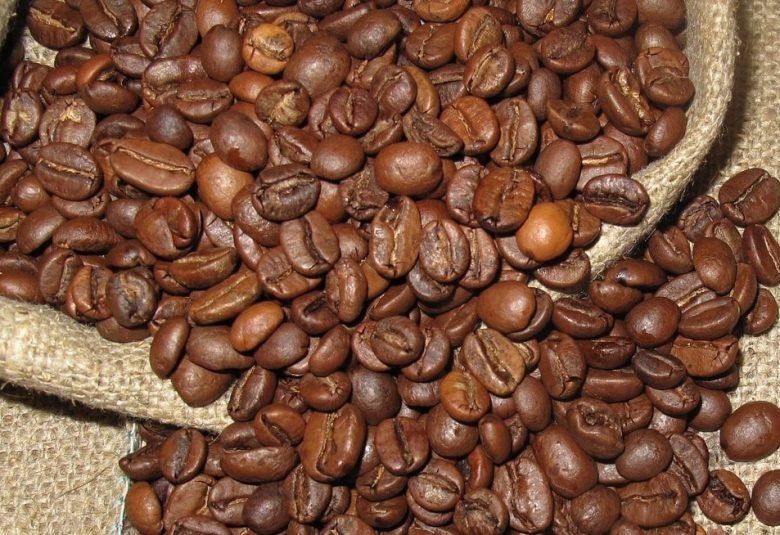
Coffee plants originate from sub-Saharan Africa, which is the countries located below the Sahara desert. The species of our interest, the Coffee arabicais native to the highlands of Ethiopia, where it grows spontaneously, and was the first coffee plant to be exported and grown on a large scale.
From these areas, it spread to the Arabian peninsula (hence the name) in particular in Yemen, up to Egypt, then to Syria, up to the Ottoman Empire at the beginning of the fifteenth century. In Istanbul, the capital of present-day Turkey, the first cafés were born, meeting places where coffee is consumed for hours =kahve.
In Europe
In Europe coffee arrives about a century later, through the deportation of Turkish slaves. As for Italy, however, in Naples it peeps out in 1600, together with the stories of this dark drink prepared in the holy land. By 1700, it was widespread and every major city had at least one coffee shop. In the mid-1700s, the coffee plant landed in Central America by the colonizers and from then on it gradually became one of the main crops on the continent, with the creation of the first large-scale plantations where slaves were exploited. To date, large-scale coffee is grown in the tropical belt of various continents, and the largest producers, after Brazil, are Vietnam, Colombia, Indonesia and Ethiopia.
Botanical characteristics of the coffee plant
The plants of Coffea arabica they are evergreen and grow like a small shrub, which generally does not exceed 5-6 m in height (obviously in pot cultivation they are much lower). The foliage has the typical pyramidal bearing. The trunk is straight, reddish in color, with the tendency to flake off the outermost part of the bark over the years.
The branches are arranged radially on the trunk, with the basal and old ones longer than the young ones, arranged in the upper part of the plant, hence the pyramidal appearance.
The root system is superficial, but quite extensive. In the natural environment, the coffee plant has an excellent longevity, over 100 years, but obviously with decreasing production over time, which is why it is grown on plantations with shorter cycles.
Leaves
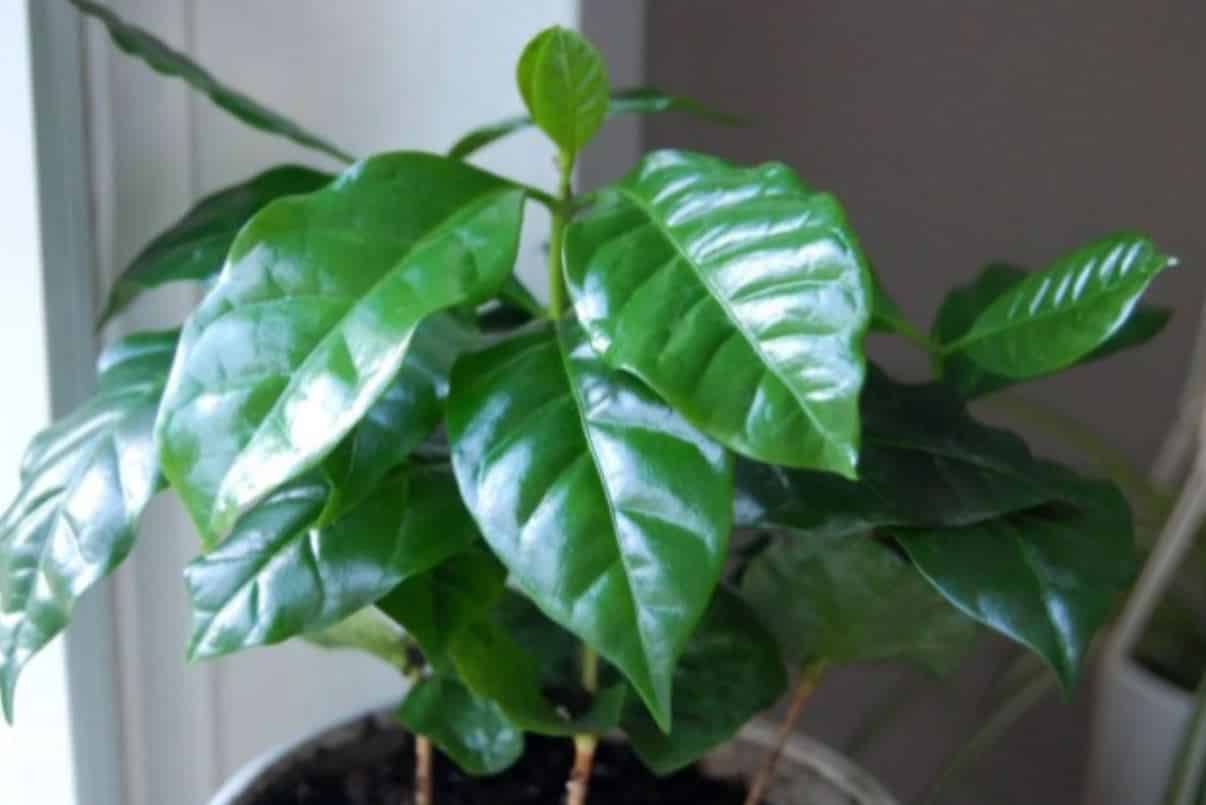
The leaves of the coffee plant are very beautiful on an ornamental level. They are shiny and of a beautiful intense green color, with evident median ribs that enhance their harmony. The shape is oval, with a pointed apex. The leaf margin is wavy, with the leaves tending to tighten towards the center.
Flowers
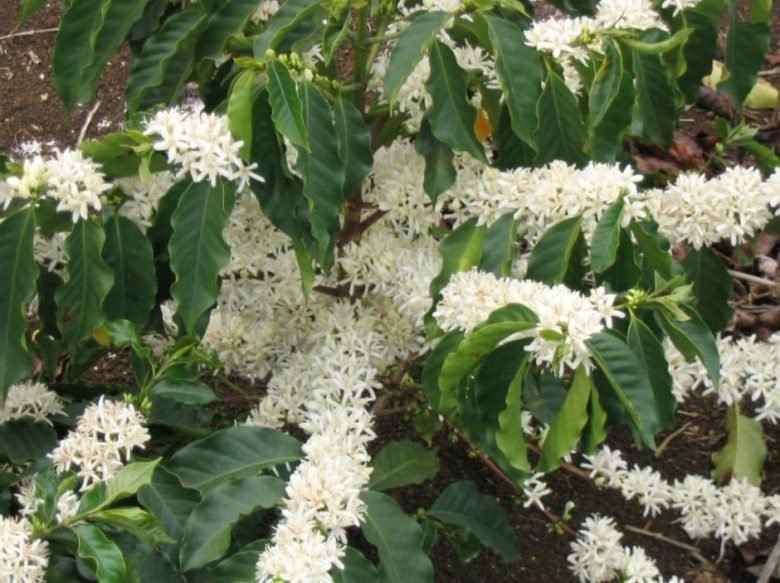
In the coffee plant the flowers are born at the axil of the leaves and in small groups. Under the right environmental conditions, they are very numerous and completely cover the different “stages” of the plant. The color is white, the smell is pleasant, the shape is a star. In tropical climates the flowering of the plant occurs practically all year round, while in our latitudes it occurs only in summer.
Fruits and seeds
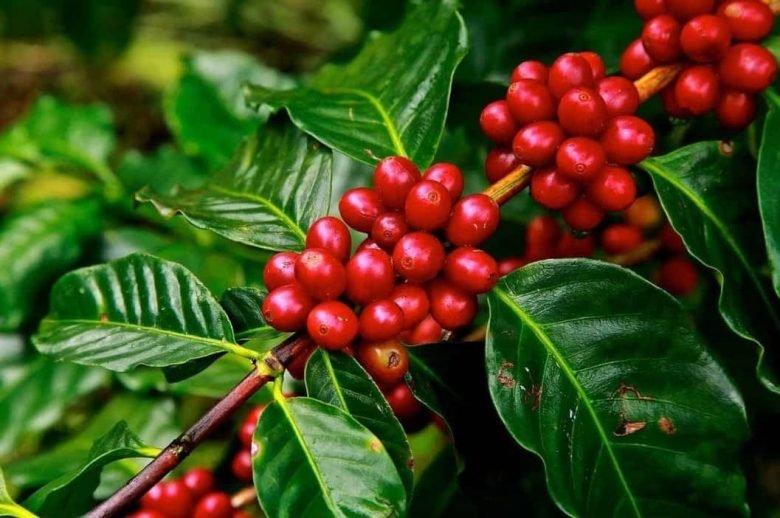
There Coffea arabica it is a self-fertile plant that pollinates itself, therefore it does not need cross-pollination. After pollination, the transformation of the ovary into fruit begins, a very slow process that can last a total of 9-10 months.
Initially the fruit is a small green dot that does not change its size for a long time. Gradually, the drupe grows, turning from green to red in color. The seeds (1-2) are kept inside the drupe, ie the classic “coffee bean” that we all know.
The cultivation of the coffee plant
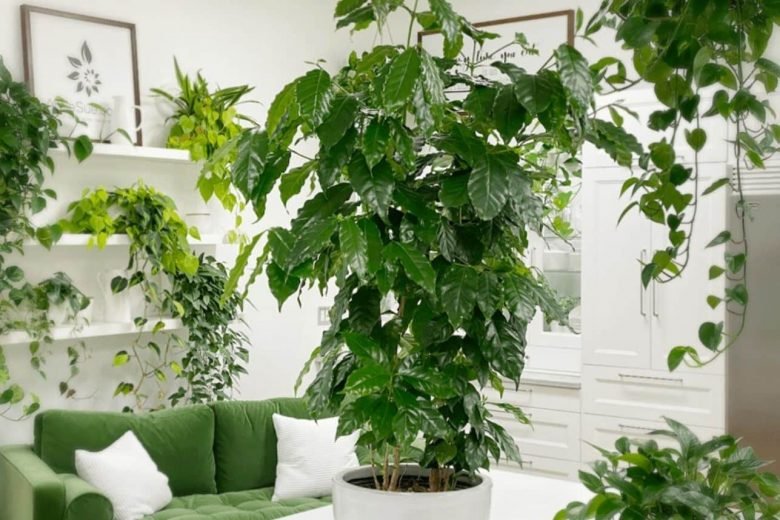
As pointed out several times, the coffee plant Coffea arabica it is grown in tropical climates. The ideal habitat is that of the mountains, characterized, in tropical latitudes, by a practically unchanged climate throughout the year, with very high humidity and constant temperatures, without extremes. Just to be clear, the optimum temperature fluctuates between 25 ° C during the day and 15 ° C at night.
In fact, coffee does not tolerate the cold, but neither does the torrid heat of our Mediterranean summers, so the climatic limit is double. This suggests we grow the plant indoors, in pots, where it can adapt more easily. Growing in pots also gives us the opportunity to move the plant outside in mild periods of the year, such as mid-spring or early autumn. The best exposure in the home is near a bright window, but away from direct sunlight and artificial heating / cooling sources.
Soil and fertilizer
If we want to grow a potted coffee plant, it is of fundamental importance to prepare the right mix of soil and fertilizer. Plant like a subacid soil pH, with a good supply of organic matter and excellent drainage. It is therefore convenient to use a soil for acidophilic plants (like this one) and mix it with organic fertilizer such as earthworm humus or ground lupins. Expanded clay must be placed on the bottom of the vase, so as not to risk water stagnation.
How to start coffee cultivation
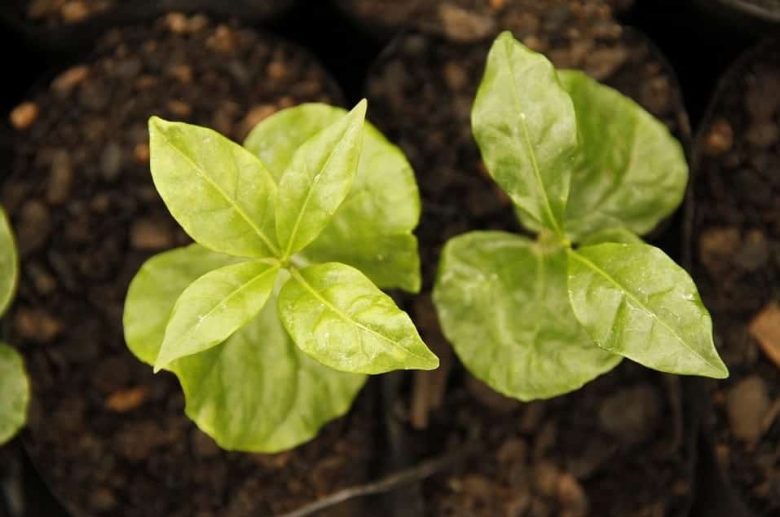
To start growing the coffee plant, the simplest thing to do is to buy a seedling or nursery in specialized stores on the net. As soon as the seedling is received, it must be transplanted into a larger container with the mix seen above. Potted plants are usually proposed with more stems, but as they grow they will take on the appearance of a shrub with more trunks, a bit like the ficus benjamin. This is because the purpose of cultivation is not the production of coffee, but the ornamental value of the plant itself. However, there are alternatives, namely the sowing and the cutting.
Reproduction from seed
Obviously, to sow a coffee plant we cannot use the seeds already roasted, but we will need to find active seeds (if you are interested you can find them here), coming from fresh and ripe berries, as well as certified.
To facilitate germination, it is advisable to keep the seeds in water for about 24 hours before proceeding with sowing. This is done in small jars, filled with soil for acidophilic plants. The best time for planting is spring. Germination is slow, it takes about 2 months. In addition, the germination rate is low, so it is best to use two coffee seeds per jar. For the first year, the plant must be kept in pots, irrigated regularly and absolutely protected from temperatures that are too hot or cold. Plants grown from seed take 2 to 4 years to first bloom.
Reproduction by cuttings
The reproduction of the coffee plant by cuttings is instead done at the beginning of summer, by taking, from the most vigorous jets of the plant, portions of 10-15 cm in length, bearing at least one bud. The coffee cutting roots well in a peat mix and garden sand, with constantly humid earth and pot kept protected from the sun and high summer temperatures. Repotting can be done in the following spring.
Repotting and fertilization
The coffee plant grows slowly in the beginning, but after the first year the annual growth is quite fast. Repotting should be done often, i.e. you shouldn’t give the plant too large a pot right away. This is because the roots grow well if they find space progressively. At the time of repotting, you can take advantage of an organic fertilization, as explained above. On average, this operation can be done twice a year, in early spring and late summer.
Irrigation
In pot cultivation of the coffee plant, irrigation must be regular, at least once a week in autumn / winter, 2-3 times in spring / summer. Be careful not to overdo the amount of water, avoiding water stagnation in the saucer, which for the purpose can be filled with expanded clay, in order to absorb excess water from the bottom of the pot.
Pruning
The pruning operations they are limited only to the removal of old or damaged branches, it is better not to overdo it with “decorative” cuts.
Leaf yellowing
Very common on the coffee plant is leaf yellowing, with subsequent fall of the leaves. This is almost always due to temperature changes that must be corrected, otherwise the plant will deteriorate.
Parasites
Among the potential parasites of the coffee plant we point out the aphids and the cochineal. However, since the plants are grown indoors, any infestation starts should be kept under control. At the first appearance of insects it is advisable to wash the leaves with water and soft potassium soap.

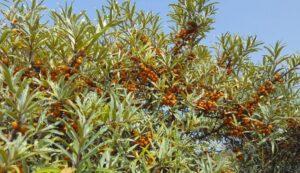
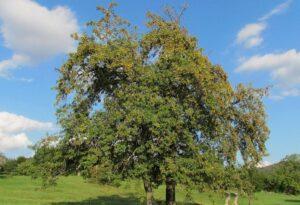
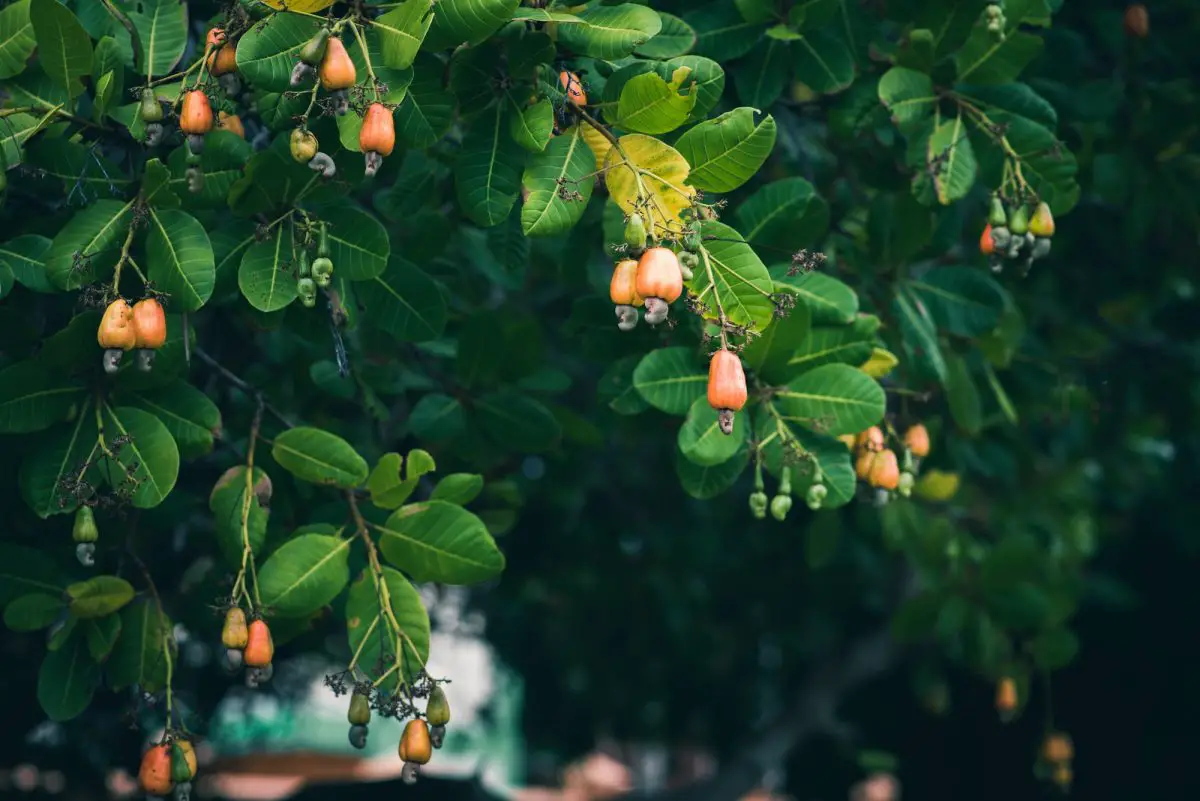
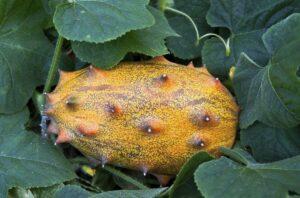
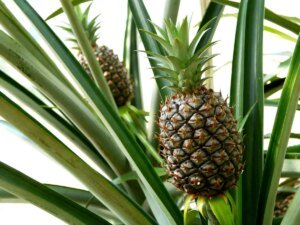
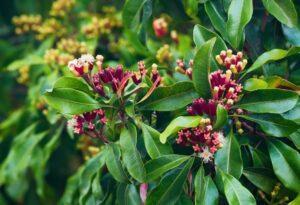
Start a new Thread